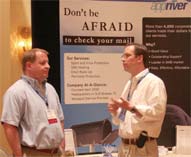CT at the Show
Online Deliberation 2005

Democracy online
Will online forums help foster an informed citizenry, ready
to participate
in the democratic process? The world’s experts in deliberative
democracy and human-computer interaction came together
this past spring at Stanford University (CA) to discuss how
technology
can change the way people interact and, ultimately, make
collective decisions. In an opening plenary panel session,
Carnegie Mellon University (PA) ethicist and philosophy professor
Robert Cavalier described PICOLA,
a Public Informed Citizens Online Assembly that
uses
software developed at CMU. His project’s goal is to create
a
high-telepresence environment for online deliberation into
which
the user is easily immersed in the virtual world.

The ‘crucible’ of deliberation
New York Law School professor Beth Simone Noveck examined
the nature of deliberation and the role of technology. “We
are
witnessing the emerging phenomenon of decentralized groups
that are able to take action using the new tools that are available
to them. If only we can better figure out how to make the
shift from the ‘interface’ to the ‘deliberative
interface.’”

Augmenting intellect
Special guest lecturer Douglas Engelbart (best known
as the inventor of the computer mouse) elaborated
on his talk, “Bootstrapping: Accelerating the Evolution
of Collective IQ,” during an informal evening discussion
group. “Humans’ capabilities depend upon
their augmentation system,” explained the humancomputer
interaction pioneer.
DIAC-2005 INBOX 2005—The E-Mail Event

Thinking inside the box
Industry groups are working hard to
make e-mail technology straightforward
for campus users. At this summer’s
INBOX in San Jose, industry leaders met
to discuss anti-phishing, compliance,
best practices, mobile apps, and more.
Sessions like this Executive Roundtable
included top leadership from companies
like CipherTrust (www.ciphertrust.com),
Cloudmark , Iron-
Port , MailFrontier ,
and Sendmail .

Higher education on the list
After a high-level plenary discussion with industry leaders,
CipherTrust CTO Paul Judge stopped to tell CT: “There is
still a lack of fundamental knowledge about the e-mail
ecosystem and how e-mails move around the Internet. In
academia, there has been lots of work looking at Web or
DNS traffic. But there is a huge opportunity for research
around e-mail…room not only for new research, but for
partnerships between universities and companies, to have
data and information-sharing relationships—to create new
research and employment opportunities for students.”

An exchange about e-mail
Companies dealing with spam filtering and other e-mail
administration issues lined the aisles of the INBOX
exhibit floor. Most of the companies serve higher education
as well as corporate customers—especially service
providers like AppRiver (www.appriver.com), whose
reps told Campus Technology that they feel their higher
ed customers are responding well to their hosted antispam
service model.